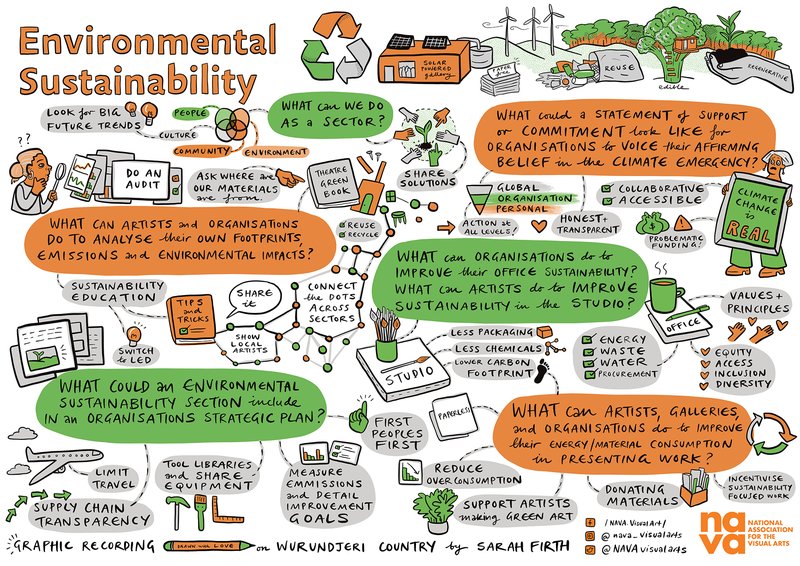Code of Practice Environmental Sustainability Consultation
Graphic by Sarah Firth.
Graphic by Sarah Firth.

Image description: Mind map using illustrations and text to provide an overview of some of the concerns raised around environmental sustainability in the arts during an open consultation with the sector in March 2022.
NAVA held an open consultation on environmental sustainability within the visual art sector for the major revision of the Code of Practice on 23 March. The meeting was opened with provocations from two guest presenters: Judy Watson (Waanyi), multi-media artist and MaryJo Lelyveld, head conservator at the National Gallery of Victoria and Sustainable Collections Committee Convenor for the Australian Institute for the Conservation of Cultural Materials (AICCM).
Participants in the meeting, including artists and organisation NAVA Members and other colleagues, discussed our responsibility in raising awareness about good practices, changing behaviours and mitigating environmental impacts. In light of current extreme weather conditions including severe flooding in parts of Queensland and New South Wales as well as dangerous high tides along the east coast, this was an urgent conversation to have and as such, NAVA is grateful for the generous contributions made by all.
While many specific and tangible actions were discussed, the overarching takeaway which emerged from the consultation meeting is that personal and organisational accountability and action is a fundamental responsibility needed to reach sustainable goals, but must be accompanied by collaborative and supportive practices throughout the sector in order to achieve them. Participants in the consultation largely acknowledged that the visual art sector has a strong role to play in taking climate action and that good progress in segments of the sector is already occurring. There was agreement that good practice and process would be underpinned by practitioners and organisations identifying shared values and principles from which actions and relationships then flow. Also articulated strongly was the need for organisations to conduct internal or external audits of their practices and in turn, environmental impact and footprint.
Given the importance of community in environmental and climate justice, sustainability should not come at the cost of cultural safety, inclusion, access and well being, rather they should be prioritised when making decisions around sustainable practices.
Many participants contributed suggestions for how individuals and organisations can share an affirming belief in the climate emergency, and tangible actions to improve sustainability:
From discussing the detail of actions and choices to the overarching principles of sustainability, it became clear that there are some shared responsibilities of the sector. These include putting First Nations voices and ecological knowledge first, publicly sharing your position, supporting artists making work on climate or environmental emergencies and advocating to organisations and government where you are able.
NAVA warmly thanks all contributors for their insights, which will be used to inform the drafting of the revised Code of Practice due for release this year.
We have now compiled the consultation feedback and provided it to the writer commissioned to draft this new section of the Code of Practice. Once drafted, we will share the new content first with a small group of practitioners and organisations working in this space, to review and provide feedback on the final draft in May 2022.
We encourage you to share any additional or urgent input ahead of finalising the draft by emailing NAVA's Code of Practice Project Manager Rhianna Pezzaniti via rhianna@visualarts.net.au.
The Code of Practice for the Professional Australian Visual Arts, Craft & Design Sector sets the national best practice standards for the sector, providing a set of practical and ethical guidelines for the conduct of business between art, craft and design practitioners and galleries, agents, dealers, retailers, buyers, sponsors and partners, commissioners, employers and the managers of residencies, workshops, competitions, prizes and awards, and more.
NAVA is currently undertaking a major revision of the Code, working with academic, legal and industry partners as well as consulting widely all over Australia. The new Code of Practice, once implemented, will more accurately reflect the contemporary practices and needs of Australian artists and arts workers and further promote the development of a robust arts ecology that can sustain and support artists’ careers while preparing organisations, institutions and policymakers for working with and for artists in financially transparent, culturally competent and ethical ways.
Follow this link to guides and resources for sustainable practices, greening the arts and taking climate action.